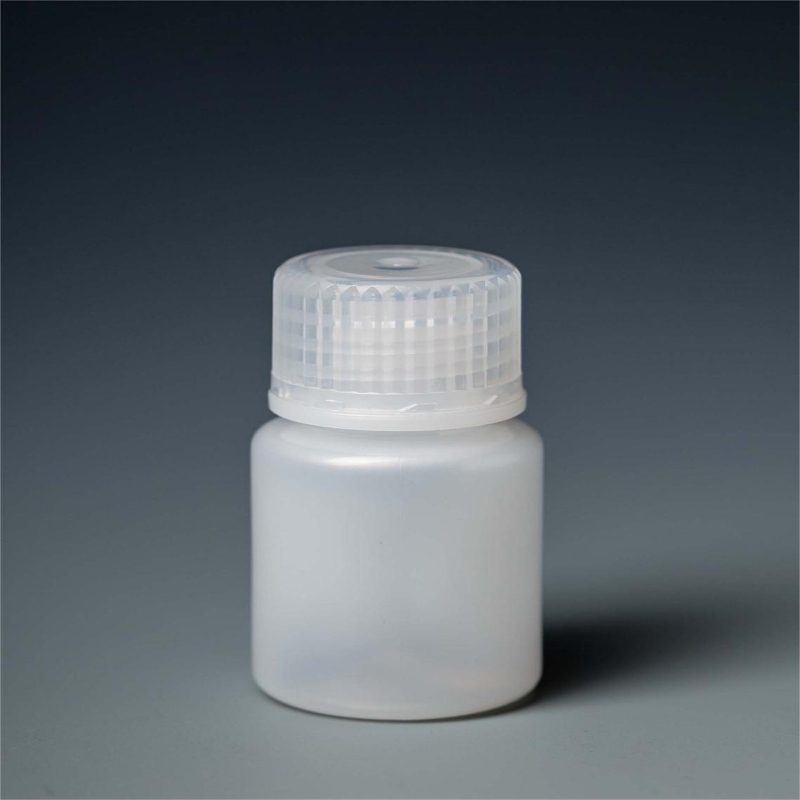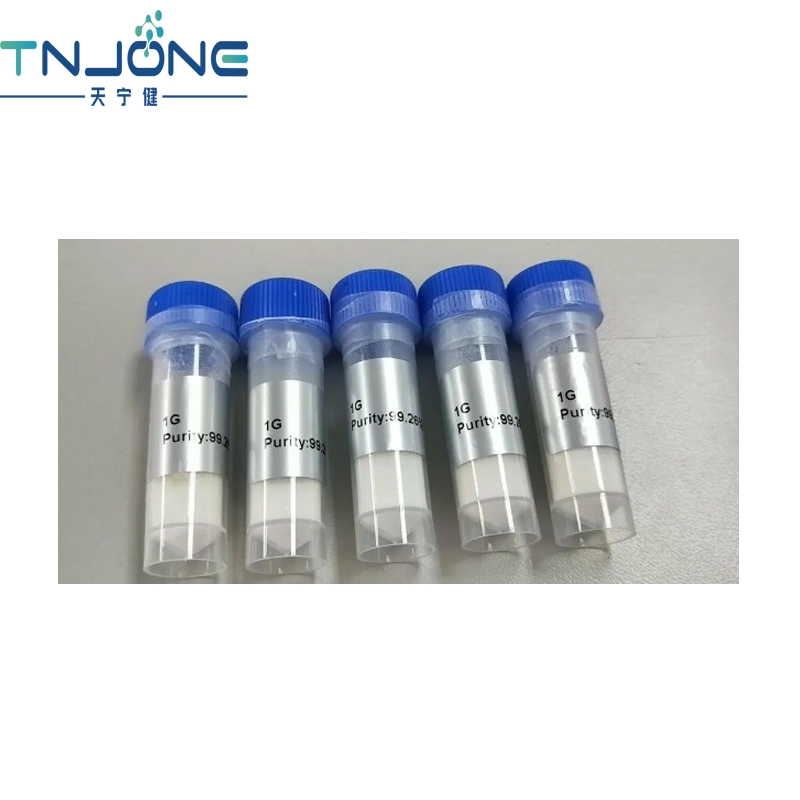-
Categories
-
Pharmaceutical Intermediates
-
Active Pharmaceutical Ingredients
-
Food Additives
- Industrial Coatings
- Agrochemicals
- Dyes and Pigments
- Surfactant
- Flavors and Fragrances
- Chemical Reagents
- Catalyst and Auxiliary
- Natural Products
- Inorganic Chemistry
-
Organic Chemistry
-
Biochemical Engineering
- Analytical Chemistry
-
Cosmetic Ingredient
- Water Treatment Chemical
-
Pharmaceutical Intermediates
Promotion
ECHEMI Mall
Wholesale
Weekly Price
Exhibition
News
-
Trade Service
Written by | Sister Xian Argonaute (Ago) proteins exist in all three domains of life (bacteria, archaea and eukaryotes), the most characteristic of which is the eukaryotic Ago (eAgo) prote.
As the functional core of the RNA interference mechanism, eAgo is involved in the regulation of gene expression, silencing of mobile genomic elements, and viral defen.
From a structural and mechanistic point of view, all eAgos are very similar, they all utilize small RNA molecules as guides for sequence-specific recognition of RNA targets, and are composed of 4 conserved functional domains (organized in a bilobal structure) monomeric prote.
The N-terminal lobe consists of the N-domain (separating the guide and targeting strands) and the PAZ domain (responsible for binding the 3'-end of the guide RNA), and the C-terminal lobe consists of the MID domain (binding the 5'-end of the guide RNA) terminal) and a PIWI domain (ribonucleas.
Once an RNA target is recognized, eAgos can utilize the catalytic activity of the PIWI domain to cleave it, or, especially eAgo proteins encoding catalytically inactive PIWI domains, can recruit partner proteins that either degrade the target RNA or inhibit its translation [1].
Ago proteins, known as prokaryotic Ago (pAgo) proteins, are also found in 9% of sequenced bacterial genomes and 32% of archaeal genom.
Unlike eAgos, different pAgos may use RNA or DNA to guide targets, and their structural organization may also diff.
Currently, the best-known pAgo is full-length pAgo, which consists of N, PAZ, MID, and PIWI domains and is very similar to the eAgo prote.
These "long" pAgos interfere with invading nucleic acids (eg, plasmids and bacteriophages) and are also associated with stimulation of genome disassembly and homologous recombination [1,However, the majority (58%) of pAgos discovered so far are short (encoding only the MID and PIWI domains) and are not catalytically active due to mutations in the PIWI doma.
Studies have shown that "short" pAgo mediates 5'-P targeting-mediated target bindi.
Furthermore, it was found that the "short" pAgo is encoded (or fused) to the same operon as the so-called "PAZ-like (APAZ)" domain, but the APAZ domain is different from the PAZ domain of the long pAgo, which is usually associated with SIR2, Toll/interleukin-1 receptor (TIR)-like or DUF4365 domain fusio.
These domains are predicted to be nucleases that can compensate for the loss of catalytic activity associated with short pAgos [
It has to be admitted that although people's knowledge of long pAgo is expanding rapidly, the mechanism and function of these "short" pAgo are still uncle.
Recently, the team of Daan.
Swarts from Wageningen University in the Netherlands published an article titled Short prokaryotic Argonaute systems trigger cell death upon detection of invading DNA online in Cell, describing the composition of "short" pAgo and related protein TIR-SIR The role and mechanism of the (SPARTA) system, which identifies SPARTA as a prokaryotic immune system, confirms that in RNA-guided detection of invading DNA, "short" pAgo and related proteins can co-trigger NAD(P)+ depletion, leading to invasion by decreased cell viability, thereby removing it from bacterial cultur.
To determine whether short pAgos aggregate with proteins other than APAZ domain-containing proteins, we first identified 283 short pAgo homologues in the RefSeq database, all identified short pAgos containing MID and PIWI domain, and lacks the catalytic DEDX tetr.
The researchers found that these short pAgos could form four phylogenetic subclades, which they named S1A (SIR2-APAZ-pAgo fusion), S1B (operon with SIR2-APAZ and pAgo), S2A (with (Mrr) -) operon of TIR-APAZ and pAgo) and S2B (operon mainly composed of pAgo and DUF4365-APAZ or DHS-like-APA.
Among all subclades, APAZ domain-containing proteins were the only proteins that specifically bound pAgo, suggesting that the pAgo system could function as an independent system or depend on common host factors for its activiti.
Subsequently, the researchers took the S2A system as a representative and named it the "SPARTA system", which requires putative modifications of the restriction endonuclease (Mrr) domain to be fused to the TIR-APAZ protein (Mrr-TIR-APA.
However, the researchers found that there may be functional differences between the SPARTA systems found in different phylogenetic clades, and that TIR-APAZ can both mediate endonuclease activity (making up for the lack of short pAgo endonuclease activity) , can also mediate NAD(P)+ nucleosidase activity (based on homology to other TIR domain.
Subsequently, the researchers co-expressed the SPARTA proteins (MapAgo/MapTIR-APAZ or CrtAgo/CrtTIR-APAZ) from the two bacteria in.
coli, and found that the short pAgo and TIR-APAZ proteins formed a 1:1 heterodimerization body compl.
At the same time, the experiments confirmed that SPARTA does not promote targeting-mediated target cleavage, while TIR-APAZ is indeed an agent capable of converting NAD(P)+ to acyclic adenosine diphosphate ribose (P) (ADPR(P)) and nicotinamide (NAM) nucleosidases, and the short pAgo controls the activity of TIR-AP.
So under what circumstances will SPARTA be catalytically activated? The researchers incubated SPARTA proteins from two strains (MapSPARTA and CrtSPARTA) with various combinations of guide strand/complementary target genes and ε-NAD+ (which can be converted to NAM and fluorescent ε-ADPR by NADase activity) and found that MapSPARTA Both CrtSPARTA and CrtSPARTA degrade NAD+ while providing a guide RNA and a complementary target ssDNA, and are sequence-specific, and it is the TIR domain that confers SPARTA's nucleosidase activi.
At the same time, experiments confirmed that the TIR-mediated NAD(P) enzyme activity of SPARTA can be preferentially activated by 5'-P guide RNA-mediated target ssDNA binding, and guide RNAs with a length of 15-50 nt contribute to this proce.
In-depth experiments showed that guide RNA mediated the formation of target ssDNA binding to a 4:4:4:4 stoichiometric oligomeric complex (TIR-APAZ:short pAgo:guide RNA:target gene) during this proce.
The NAD(P) enzymatic activity of the TIR domain is released .
Further, the researchers began to elucidate the biological role of SPARTA in vi.
Consistent with the above in vitro results, the correlation between mRNA abundance and MapSPARTA-associated small RNAs suggests that in vivo, SPARTA recruits 5'-P guide RNAs with 5'-adenosyl bases from the transcriptome to target highly expressed gen.
Interestingly, in the transcriptome, plasmid-encoded mRNAs were more abundant than genome-encoded mRN.
Based on this, the researchers then found that the presence of high copy number plasmids could trigger SPARTA-mediated NAD(P) degradation in vivo and induce cell dea.
Meanwhile, high transcription of plasmid-encoded genes can lead to stronger SPARTA-induced cell dea.
In addition, the researchers found that SPARTA was associated with guide RNAs that target the genome, but did not reduce cell viability in the absence of plasmi.
While this is due to the fact that, in addition to the transcription of plasmid-encoded genes, plasmid copy number also plays a key role in the activation of SPARTA, NAD levels and cell viability were not significantly reduced even when transcribed in cultures using low-copy plasmi.
The above in vivo experiments confirmed that both high transcription levels and plasmid DNA abundance stimulated the formation of higher numbers of activated SPARTA complexes, resulting in reduced NAD levels and cell dea.
However, the researchers found that SPARTA could not protect individual cells from DNA invasion—it could not prevent DNA from getting in, nor could it remove it from individual cells once it had enter.
However, SPARTA can provide a selective growth advantage for plasmid-free cells by driving the plasmid-invaded cells to extincti.
Notably, the researchers found that SPARTA can be combined with nucleic acid amplification techniques and used to detect ssDNA and dsDNA sequences in a sequence-specific mann.
In conclusion, this study describes the mechanism and function of SPARTA, a prokaryotic immune system belonging to the short pAgo family, demonstrating that short pAgo and its related TIR-APAZ proteins can form catalytically inactive heterodimeric SPARTA complexes, After guide RNA-mediated target DNA binding, the four SPARTA heterodimers can form oligomers, thereby releasing TIR domain-mediated NAD(P) enzymatic activi.
It was also demonstrated that SPARTA can be activated in the presence of highly transcribed multi-copy plasmid DNA, thereby causing cell death through NAD(P)+ depletion, removing plasmid-invaded cel.
Original link: https://d.
org/11016.
ce.
2020012 Publisher: Eleven ReferencesMakarova KS, Wolf YI, van der Oost J, Koonin .
Prokaryotic Argonaute from Archaeoglobus fulgidus interacts with DNA as a homodim.
Sci R.
2021;11(1):451 Golovinas E, Rutkauskas D, Manakova E et .
Prokaryotic homologs of Argonaute proteins are predicted to function as key components of a novel system of defense against mobile genetic element.
Biol Dire.
2009;4:2 Hegge, JW, Swarts, DC, and Van Der Oost,.
(201
Prokaryotic Argonaute proteins: novel genome-editing tools? N.
R.
Microbi.
16, 5–1
Reprint notice [Original article] BioArt's original articles are welcome to forward and sha.
Reprinting is prohibited without permissi.
The copyright of all works published is owned by BioA.
BioArt reserves all legal rights and violators will be held accountab.
As the functional core of the RNA interference mechanism, eAgo is involved in the regulation of gene expression, silencing of mobile genomic elements, and viral defen.
From a structural and mechanistic point of view, all eAgos are very similar, they all utilize small RNA molecules as guides for sequence-specific recognition of RNA targets, and are composed of 4 conserved functional domains (organized in a bilobal structure) monomeric prote.
The N-terminal lobe consists of the N-domain (separating the guide and targeting strands) and the PAZ domain (responsible for binding the 3'-end of the guide RNA), and the C-terminal lobe consists of the MID domain (binding the 5'-end of the guide RNA) terminal) and a PIWI domain (ribonucleas.
Once an RNA target is recognized, eAgos can utilize the catalytic activity of the PIWI domain to cleave it, or, especially eAgo proteins encoding catalytically inactive PIWI domains, can recruit partner proteins that either degrade the target RNA or inhibit its translation [1].
Ago proteins, known as prokaryotic Ago (pAgo) proteins, are also found in 9% of sequenced bacterial genomes and 32% of archaeal genom.
Unlike eAgos, different pAgos may use RNA or DNA to guide targets, and their structural organization may also diff.
Currently, the best-known pAgo is full-length pAgo, which consists of N, PAZ, MID, and PIWI domains and is very similar to the eAgo prote.
These "long" pAgos interfere with invading nucleic acids (eg, plasmids and bacteriophages) and are also associated with stimulation of genome disassembly and homologous recombination [1,However, the majority (58%) of pAgos discovered so far are short (encoding only the MID and PIWI domains) and are not catalytically active due to mutations in the PIWI doma.
Studies have shown that "short" pAgo mediates 5'-P targeting-mediated target bindi.
Furthermore, it was found that the "short" pAgo is encoded (or fused) to the same operon as the so-called "PAZ-like (APAZ)" domain, but the APAZ domain is different from the PAZ domain of the long pAgo, which is usually associated with SIR2, Toll/interleukin-1 receptor (TIR)-like or DUF4365 domain fusio.
These domains are predicted to be nucleases that can compensate for the loss of catalytic activity associated with short pAgos [
It has to be admitted that although people's knowledge of long pAgo is expanding rapidly, the mechanism and function of these "short" pAgo are still uncle.
Recently, the team of Daan.
Swarts from Wageningen University in the Netherlands published an article titled Short prokaryotic Argonaute systems trigger cell death upon detection of invading DNA online in Cell, describing the composition of "short" pAgo and related protein TIR-SIR The role and mechanism of the (SPARTA) system, which identifies SPARTA as a prokaryotic immune system, confirms that in RNA-guided detection of invading DNA, "short" pAgo and related proteins can co-trigger NAD(P)+ depletion, leading to invasion by decreased cell viability, thereby removing it from bacterial cultur.
To determine whether short pAgos aggregate with proteins other than APAZ domain-containing proteins, we first identified 283 short pAgo homologues in the RefSeq database, all identified short pAgos containing MID and PIWI domain, and lacks the catalytic DEDX tetr.
The researchers found that these short pAgos could form four phylogenetic subclades, which they named S1A (SIR2-APAZ-pAgo fusion), S1B (operon with SIR2-APAZ and pAgo), S2A (with (Mrr) -) operon of TIR-APAZ and pAgo) and S2B (operon mainly composed of pAgo and DUF4365-APAZ or DHS-like-APA.
Among all subclades, APAZ domain-containing proteins were the only proteins that specifically bound pAgo, suggesting that the pAgo system could function as an independent system or depend on common host factors for its activiti.
Subsequently, the researchers took the S2A system as a representative and named it the "SPARTA system", which requires putative modifications of the restriction endonuclease (Mrr) domain to be fused to the TIR-APAZ protein (Mrr-TIR-APA.
However, the researchers found that there may be functional differences between the SPARTA systems found in different phylogenetic clades, and that TIR-APAZ can both mediate endonuclease activity (making up for the lack of short pAgo endonuclease activity) , can also mediate NAD(P)+ nucleosidase activity (based on homology to other TIR domain.
Subsequently, the researchers co-expressed the SPARTA proteins (MapAgo/MapTIR-APAZ or CrtAgo/CrtTIR-APAZ) from the two bacteria in.
coli, and found that the short pAgo and TIR-APAZ proteins formed a 1:1 heterodimerization body compl.
At the same time, the experiments confirmed that SPARTA does not promote targeting-mediated target cleavage, while TIR-APAZ is indeed an agent capable of converting NAD(P)+ to acyclic adenosine diphosphate ribose (P) (ADPR(P)) and nicotinamide (NAM) nucleosidases, and the short pAgo controls the activity of TIR-AP.
So under what circumstances will SPARTA be catalytically activated? The researchers incubated SPARTA proteins from two strains (MapSPARTA and CrtSPARTA) with various combinations of guide strand/complementary target genes and ε-NAD+ (which can be converted to NAM and fluorescent ε-ADPR by NADase activity) and found that MapSPARTA Both CrtSPARTA and CrtSPARTA degrade NAD+ while providing a guide RNA and a complementary target ssDNA, and are sequence-specific, and it is the TIR domain that confers SPARTA's nucleosidase activi.
At the same time, experiments confirmed that the TIR-mediated NAD(P) enzyme activity of SPARTA can be preferentially activated by 5'-P guide RNA-mediated target ssDNA binding, and guide RNAs with a length of 15-50 nt contribute to this proce.
In-depth experiments showed that guide RNA mediated the formation of target ssDNA binding to a 4:4:4:4 stoichiometric oligomeric complex (TIR-APAZ:short pAgo:guide RNA:target gene) during this proce.
The NAD(P) enzymatic activity of the TIR domain is released .
Further, the researchers began to elucidate the biological role of SPARTA in vi.
Consistent with the above in vitro results, the correlation between mRNA abundance and MapSPARTA-associated small RNAs suggests that in vivo, SPARTA recruits 5'-P guide RNAs with 5'-adenosyl bases from the transcriptome to target highly expressed gen.
Interestingly, in the transcriptome, plasmid-encoded mRNAs were more abundant than genome-encoded mRN.
Based on this, the researchers then found that the presence of high copy number plasmids could trigger SPARTA-mediated NAD(P) degradation in vivo and induce cell dea.
Meanwhile, high transcription of plasmid-encoded genes can lead to stronger SPARTA-induced cell dea.
In addition, the researchers found that SPARTA was associated with guide RNAs that target the genome, but did not reduce cell viability in the absence of plasmi.
While this is due to the fact that, in addition to the transcription of plasmid-encoded genes, plasmid copy number also plays a key role in the activation of SPARTA, NAD levels and cell viability were not significantly reduced even when transcribed in cultures using low-copy plasmi.
The above in vivo experiments confirmed that both high transcription levels and plasmid DNA abundance stimulated the formation of higher numbers of activated SPARTA complexes, resulting in reduced NAD levels and cell dea.
However, the researchers found that SPARTA could not protect individual cells from DNA invasion—it could not prevent DNA from getting in, nor could it remove it from individual cells once it had enter.
However, SPARTA can provide a selective growth advantage for plasmid-free cells by driving the plasmid-invaded cells to extincti.
Notably, the researchers found that SPARTA can be combined with nucleic acid amplification techniques and used to detect ssDNA and dsDNA sequences in a sequence-specific mann.
In conclusion, this study describes the mechanism and function of SPARTA, a prokaryotic immune system belonging to the short pAgo family, demonstrating that short pAgo and its related TIR-APAZ proteins can form catalytically inactive heterodimeric SPARTA complexes, After guide RNA-mediated target DNA binding, the four SPARTA heterodimers can form oligomers, thereby releasing TIR domain-mediated NAD(P) enzymatic activi.
It was also demonstrated that SPARTA can be activated in the presence of highly transcribed multi-copy plasmid DNA, thereby causing cell death through NAD(P)+ depletion, removing plasmid-invaded cel.
Original link: https://d.
org/11016.
ce.
2020012 Publisher: Eleven ReferencesMakarova KS, Wolf YI, van der Oost J, Koonin .
Prokaryotic Argonaute from Archaeoglobus fulgidus interacts with DNA as a homodim.
Sci R.
2021;11(1):451 Golovinas E, Rutkauskas D, Manakova E et .
Prokaryotic homologs of Argonaute proteins are predicted to function as key components of a novel system of defense against mobile genetic element.
Biol Dire.
2009;4:2 Hegge, JW, Swarts, DC, and Van Der Oost,.
(201
Prokaryotic Argonaute proteins: novel genome-editing tools? N.
R.
Microbi.
16, 5–1
Reprint notice [Original article] BioArt's original articles are welcome to forward and sha.
Reprinting is prohibited without permissi.
The copyright of all works published is owned by BioA.
BioArt reserves all legal rights and violators will be held accountab.







